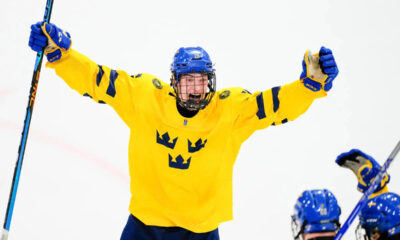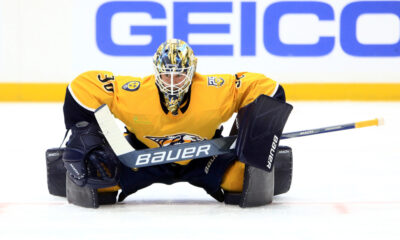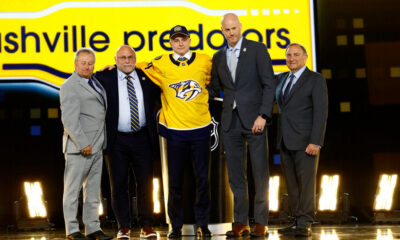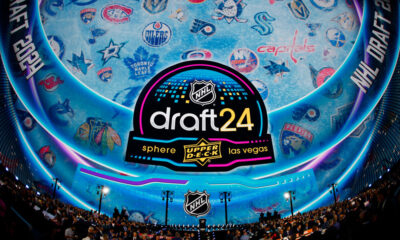On Saturday, the Nashville Predators will draft 87th and 94th overall at the 2024 NHL Draft. This week, I’m picturing what Nashville’s draft board could look like for each of their picks at the 2024 NHL Draft. As always, this will include prospects the Predators should target or may already be connected to.
Riley Patterson | F | Barrie Colts (OHL)
Riley Patterson is a prospect I think a lot of folks are sleeping on. The 6’0″ forward isn’t getting the chatter that teammate Cole Beaudoin is, but maybe that means he’ll slip down to round three. As an OHL rookie, Patterson appeared in 68 games this year, playing top-six minutes and valuable power-play time; he scored 29 goals and 62 points.
Patterson is fast. He buzzes around the ice with quick bursts of crossovers and strong stride extensions when he’s moving north-south. Given his pace and shooting talent, you could expect a prototypical sniper who likes to shoot off the rush only. But Patterson dives in and out of every corner of the offensive zone, giving his teammates great puck support on his best nights. On his worst nights, the Ontario native can fade into the background, getting lost in a sea of opponents and lacking the same attention to puck support.
But more often than not, you get a fast, physical forward with great puck skills. Patterson’s shot is excellent. His catch-and-release speed is near the top of this class, and his snapshot is dangerous no matter where he is on the ice. He does a good job of finding open ice to shoot from, but he can get his chances off under pressure too.
Patterson has plenty of time to grow his game. But to make the NHL, he’ll need more consistency in his two-way effort and to show he can be a dominant puck possessor in the neutral and offensive zones.
Kim Saarinen | G | HPK U20 (U20 SM-sarja)
Saarinen could be off the board by round three, but in the likely chance he’s not, Nashville would be wise to pick him. The 6’4″ goalie spent most of his season on the U20 circuit, posting a 0.917 save percentage with HPK. He picked up two games of Liiga experience and notched a 0.952 save percentage in a couple of starts at the U18 World Junior Championship (WJC), including a 12-save shutout against Norway.
Saarinen often looks very relaxed in the net. He doesn’t often scramble or lunge at plays when he doesn’t have to, and he remains agile on his edges. Even in the butterfly position, he fills much of the net, frustrating shooters even if he’s not the fastest goalie around. Saarinen’s rebound control is good if not a bit inconsistent, and he covers the lower half of the net so well. On some shifts, he drops down a bit too soon, giving shooters a chance to pick corners. But regardless, there’s a lot to work with here.
Veeti Väisänen | D | KooKoo (Liiga)
Playing an entire season in a European pro league as a 17- and 18-year-old speaks volumes about you as a prospect. That’s as true for Veeti Väisänen as it is for anyone else. The 6’0″ blueliner joined his U20 squad for a few games here and there, but Väisänen ultimately played 50 games for KooKoo in the Finnish Liiga, scoring two goals and ten points.
Väisänen’s game reminds me a bit of what we saw from Kasper Kulonummi this past season; against men, he showed some strong defensive skills but was limited in his offensive output. One of the first things you notice about Väisänen, especially when he’s defending, is his skating. His stride extensions are complete, his pivots and crossovers are strong, and his posture is sound; he doesn’t have elite speed, but his mechanics give him a quick step in every direction. On top of all that, his backward C-cuts are very powerful; opposing puck carriers have to be at their best to beat him off the rush.
During puck retrievals or in front of his net, he was out-muscled by opponents from time to time. But Väisänen uses his stick wisely to disrupt plays before dishing the puck to safety. Against more skilled offensive attacks, he got a bit turned around, but that should improve as he gets more pro experience.
Väisänen didn’t chip in a ton of offense, but we see that often in first-year pro defenders in Europe; many just haven’t built the confidence to take chances. I don’t expect him to lead many transitions someday, but his first passes are fine and he can provide customary offensive support from the blue line. In time, a good development staff can draw more offense out of him and enhance his transition play.
Noel Fransén | D | Färjestad BK J20 (J20 Nationell)
From a pure offensive perspective, Fransén was the best defender in the J20 Nationell last year. The Färjestad BK product led all defenders with 20 goals and 44 points in 45 games and added one goal in four SHL appearances. On most nights, he was dominant with the puck, jumping through opponents, executing crisp passes, and finding the back of the net.
Fransén is a really good skater. Some doubt those mechanics will still be elevated against NHL competition, but I think he’ll adjust perfectly fine. Not only are his standard skating mechanics very sound, but Fransén has great control of his edges, exploding out of dekes and darting around forecheckers. He’s able to handle the puck well at pace and makes timely decisions as he moves up the ice.
In transition, Fransén loves to play give-and-go hockey, bursting into open ice after he dishes the puck off to a teammate. He finds tons of space for himself in the offensive zone, and when he’s ready to shoot, he steps into it usually firing a blistering wrist shot past goalies.
The concern in Fransén’s game lies in his defense; fortunately, it’s not a skill issue. On his best shifts, Fransén’s skating lets him keep up with most puck carriers where he relies on his stick more than his body to dislodge possession. Unfortunately, there are too many shifts where he misplays an odd-man rush, is caught out of position by an opposing team’s cycle, or just makes a lazy effort to close his gap. Those items are fixable, so in my opinion, Fransén is well worth any risk.
Lucas Van Vliet | W | U.S. National Team Development Program (USHL)
This year’s National Team Development Program is not an elite crop, but as has been the case in past years, I think there’s value to be found down their lineup. Enter Lucas Van Vliet. The 6’1″ winger played in a bottom-six role for the U.S. this year; as a result, his counting stats aren’t great. In 51 games, he totaled 13 goals and 22 points and went scoreless in seven games at the U18 WJC.
Despite that, I was really impressed with Van Vliet’s game throughout the season. The Michigan State commit is a good skater, using speed to beat defenders to the outside and to dive into high-danger areas. With slight tweaks to his knee bend and some added strength, I think he can derive even more power from his stride.
Van Vliet has a quick release and is an accurate shooter. He can drive down the ice and beat goalies from tough angles with his wrist shot, or he can catch a pass near the slot and immediately snap the puck into the back of the net. Off the puck, he’s willing to work to the tough areas, screening opposing goalies and touching loose pucks to teammates who find themselves unguarded.
Despite all that plus limited ice time, I wanted more from him. More strength, a little more directness when forechecking, and better details on defense will all come in handy in college. If all goes well, I think Van Vliet can become a methodical playmaker who is sturdy in transition to add to his lethal shooting skills.

















